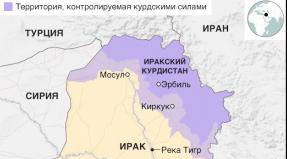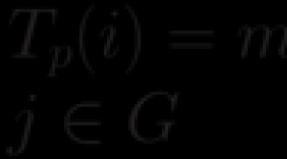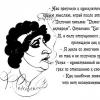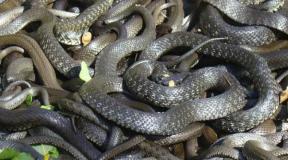Injuries to the extensor tendons of the fingers. Diagnostics, treatment. Treatment of injuries of the extensor tendons of the hand in the distal and proximal phalanx Tearing the extensor tendon of the finger treatment
Unlike tendon injuries flexor tendon injuries are often neglected due to the widespread concept of relatively favorable outcomes in injuries of this localization, with a low incidence of late complications. Nevertheless, the extensor tendons represent the final structure of a complex apparatus that transfers the efforts of the external and internal muscles to the balanced function of the finger that is necessary for a person (“external” refers to the muscles that are represented only by their tendons on the hand). Damage at any level of this well-oiled mechanism, be it bone, skin, tendon-muscle formations, vessels or nerves, can lead to stiffness and disorganization of the functions of the fingers.
For ease of evaluation damage, and to a certain extent for the choice of the method of treatment, the extensor tendon in the area of the hand and the distal forearm is divided into eight zones. Damage to zone I (hammer toe) is accompanied by a violation of the extension mechanism at the level of the distal interphalangeal joint, resulting in a typical hammer toe deformity. This closed injury results from the sudden flexion of the terminal phalanx, which is in the position of maximum extension. As a result, there is a rupture of the end of the tendon or separation of the tendon from the bone along with bone fragments of various sizes. Active extension of the distal phalanx becomes impossible. A similar deformation can result from cut wounds or other open injuries of the skin, combined with tendon injury.
In the early days treatment of closed tendon injuries at the level of the distal interphalangeal joint, it should be splinted for up to six weeks in the position of extension of the terminal phalanx. The other joints of the finger or hand must remain unblocked, including maintaining vigorous movement in the proximal interphalangeal joints. If, at the end of the 6-week period, extension is difficult, it is possible for the next six weeks to continue immobilization only at night, followed by strict control. For any relapse, splinting should be resumed continuously for another three weeks. With prolonged use of plaster immobilization, it is necessary to pay attention to the condition of the skin in order to avoid their maceration and necrosis. For more reliable assistance with subluxation in the distal interphalangeal joints, one of the methods of operative fixation with wires is sometimes used.
Open damage hammer toe can be a serious treatment problem. For transverse cut wounds, it is better to suture the tendon and skin with separate sutures using non-absorbable sutures. If the ends cannot be brought together, they resort to skin grafting and primary plastic replacement of the tendon defect, or reconstructive surgery is performed at a later period. Emergency care includes wound / joint lavage, dressing, antibiotics wide range actions, splinting in the extension position and subsequent rapid preparation for surgery, which should take place in the next 24 hours.
Zone II includes tendon injuries in the projection of the diaphysis of the middle phalanx. Trauma is usually caused by cut wounds or open fractures. A tendon injury of less than 50% of its width without impairing the extension function can be treated conservatively, with wound care and 7-10 days of extension splinting, followed by active development of movements. In case of damage of more than 50% or difficulty in extending the DMFS, the continuity of the tendon should be restored, followed by splinting or fixation of the extended DMFS with knitting needles for 6-8 weeks according to the hammer toe treatment protocol. In case of open fractures with an injury to the extensor, the fracture is treated and the tendon is reconstructed with the further implementation of a set of measures aimed at restoring motor activity.
Detachment central leg tendon stretching in the area of its attachment to the middle phalanx is referred to damage to zone III with an initial violation of the extension mechanism in the PMPS. In the absence of treatment, such injuries end in subluxation of the lateral portions of the extensor in the palmar direction with the development of a classic boutonniere-type deformity after 1-2 weeks, in which the middle phalanx is bent and the terminal phalanx is in the hyperextension position. Examination of the patient reveals the limitation or absence of active extension in the PMPS. With a closed fresh injury pain and swelling in the PMPS area can make it difficult to diagnose a central pedicle avulsion. In such cases, the most rational tactics include splinting the extended PMFS, monitoring the patient and re-examination after seven days. The metacarpophalangeal and DMFS are not subject to immobilization together with PMPS. If after a week the diagnosis of closed separation of the central pedicle is confirmed clinical manifestations, plaster immobilization is continued for 4-6 weeks with a weekly examination. At the end of the immobilization period, planned rehabilitation of the full range of motion follows.
At open damages of zone III carry out wound treatment, including washing, removal of non-viable tissues, arthrotomy according to indications and plastic closure of the defect with a lack of local soft tissues. The tendon is repaired with primary sutures, or it is given the opportunity of natural fusion under conditions of transarticular wire fixation for 4-6 weeks. In this zone, there is a possibility of healing by secondary intention, since due to the structure of the extension apparatus, retraction of the detached part does not occur during the retention of the PMPS in the extension position.
Zone IV located above the proximal phalanx. Damage to the extensor tendon in this area is often the result of a fracture of the proximal phalanx. The tendon distension is wide enough here, which explains the high frequency of incomplete ruptures. But even with a complete rupture, the severed tendon does not migrate in the proximal direction, but is held in place by sagittal bundles, similar to damage to zone III.
Tendon strain at the level of zone IV affects a relatively wide space, therefore, in most cases, for the completeness of examination and treatment, it becomes necessary to expand the incised wounds surgically. In some patients, it is possible to bring together the ends of the tendon with intra-tendon sutures. But since the tendon bundle in this area often remains flat, this type of suture may not keep the connection in a reliable state. In such cases, the tendon can be sutured with simple detached or near / far-far / near sutures (horizontal mattress sutures) to accomplish the task at hand. Early movements in active flexion and passive extension are recommended.
If zone IV damage combined with fractures of the proximal phalanx, stable fixation of the fracture greatly simplifies the early connection of the tendon to the finger.
Open injuries of zone V usually arise from a punch to the teeth of an opponent. In this chapter, the treatment of such wounds is discussed in the section "Infection". Closed injuries are not typical for this area and, as a rule, affect the radial portion of the transverse ligament, which leads to subluxation or dislocation of the extensor tendon of the fingers into the intercarpal space from the ulnar side. It should be remembered that such trauma can occur in older people against the background of involutive changes.

If you can deliver diagnosis in the next 2-3 weeks after injury, then traumatic or degenerative rupture of the transverse ligament can be treated conservatively. To do this, the joints are fixed with a plaster cast, in which the wrist is in a neutral position, the metacarpophalangeal MPS (PPS) are extended, and the PMPS and DIPJ are free, or a bridge splint is applied in the same position of the finger, specially designed for damage to the transverse ligament. In case of late diagnosis or unsatisfactory results of 6-8 weeks of splinting, centering of the tendon should be performed operatively.
Zone VI Damage localized distal or proximal to the tendon joints connecting the common extensor tendons (ARF). It is not always easy to detect a proximally located damage to one tendon of the RRP, since the extension of the finger in the MFJ does not suffer due to the indirect action of the adjacent tendon through the tendon junction. Additional methods examinations, such as ultrasound or MRI, have a low diagnostic value in such a situation, and the only way to make a diagnosis is a physical examination. Likewise, it is difficult to diagnose ruptures of the index finger (RNP) and least finger (RNP) extensors, since their extension can provide RRP. Both a rupture of the RRP proximal to the tendon junction and an isolated injury to the RRP or RRR tendon will result in displacement of the proximal end of the tendon. Often, the end of the RUP or RNP tendon can extend to the level of the extensor retainer. In this regard, examination in the operating room is more expedient than in the department. emergency care... As a rule, damage to the tendon at this level can be repaired with intra-trunk sutures, supplemented by suturing of the epithendinium.
Open damage to zone VI can be combined with extensive soft tissue defects, which often requires staged skin grafting and primary or delayed restoration of the integrity of the tendon by suturing or by transplanting a tendon graft.
V zone VII ruptures occur at the tendon retainer, where the muscle tendons are located in the six synovial sheaths. Injuries to this area are also characterized by a displacement of the ends of the extensor, which makes elective surgery inevitable. Operative treatment should be very careful to avoid fusion of the tendon with the superior retainer, with lengthening of which it is often necessary to close the wound with Z-plasty. Retainer failure leads to abnormal protrusion of the extensor tendons in the wrist. Tendon ruptures can be associated with trauma to the sensitive branches of the radial and ulnar nerves, the damage of which should be borne in mind when the nerves are quickly recognized and sutured using microsurgical techniques. The concomitant injuries of the nerves left without attention lead not only to a loss of sensitivity in the dorsum of the hand, but also to neuropathy with chronic pain syndrome.
Damage to Zone VIII touch the area of the tendon-muscle junction of the extensor. The trauma here is always penetrating, with a small entrance hole or massive soft tissue damage, and is often the result of open fractures of the forearm bones. On initial examination of a penetrating wound, usually from a knife or from a cut with a glass shard, a discrepancy can be found between a relatively small wound on the skin and significant destruction of the underlying tissues, even with preserved normal extension function. As for stitching the tendon-muscle junction itself, the difficulty lies in the eruption of muscle tissue while tightening the knots. Continuity of the connection is ensured by sutures in the shape of the big eight, followed by a period of immobilization of four to six weeks in the position of 20 ° extension of the hand and 20 ° flexion in the MFJ. Good restoration of functions is possible when the injury is localized distal to the posterior interosseous nerve of the forearm.
A ruptured extensor tendon of the finger requires compulsory treatment. After the trauma, the tendons are pretreated.
Until now, the debate continues on how to manage patients with tendon rupture in the "non-human place", the area from the base of the thumb to the metacarpophalangeal joint. The restoration of the extensor tendon of the finger in these areas is especially successful in children under 8 years of age. It is difficult to achieve a positive result in adults, therefore, the primary treatment of the tendon in this area should be carried out by a specialist in tendons.
A finger extensor tendon rupture should be repaired no later than 6 hours after injury. In the absence of infection, sufficient local treatment and correct general management of the patient, in rare cases, this period can be increased to 24 hours. It must be remembered that tendon surgery requires careful and delicate tissue handling, which is why this type of surgery is performed by specialist surgeons in this field. In this case, poor treatment is worse than none, just as excessive surgery can lead to a failure. Suture of the tendon is not done when the wound is infected.
Preparing for surgery
The area of the rupture is covered with a sterile gauze pad to prevent further contamination, the skin around the wound is shaved and washed thoroughly with soap and water. Fat and other poorly soluble substances are removed with special solutions, thus the skin is prepared.
Technique for a ruptured finger extensor tendon
The wound is opened and abundantly irrigated with warm saline solution, then covered with sterile sheets, a tourniquet is applied to the shoulder. First, the limb is raised above the level of the heart to ensure venous outflow, then an elastic bandage is applied from the fingertips upward. Normally, in an adult, the pressure rises to 250 mm Hg. Art. After that, the elastic bandage is removed. The tourniquet can remain on the arm for 1-1.5 hours. Then it is removed for 15 minutes, then to be applied again for 1 hour.
An incision is made to widen the wound. But care must be taken that these incisions correspond to the anatomical structure, correspond to the skin folds formed when the palm is squeezed and do not cross the skin folds of the wrist. An improper cut can lead to significant deformation.
Surgical treatment and wound debridement are performed. It is often necessary to widen the edges of the wound. The adjacent vessels and nerves are isolated and pulled to the side. If possible, the edges of the finger extensor tendon are grasped with tweezers. If the extensor tendon of the thumb is torn, the proximal end of the torn tendon can be pulled towards the wrist. It is then isolated through a small transverse incision in the wrist and returned to its place using a metal probe. The wrist incision is sutured. In case of damage to the flexor tendons in the palm area, their distal ends are visible in the wound when the fingers are bent. Their proximal ends can be brought out into the wound by squeezing the abdomen of the corresponding muscle on the forearm. A blind search for the "left" end of the tendon is excluded. An additional incision is almost always made along the tendon.
Tendon suture
Small, straight haemostatic clamps are placed on the ends of the tendon as close to the rupture site as possible. To restore the integrity of the tendon, a single non-absorbable suture is applied using 2 straight needles. The first needle extends 1.5 cm from the break. The length of the seam must be the same, the second needle must necessarily pass 1/3 of the distance to the break. To avoid rupture of the suture, the second needle must pass through the tendons before the first needle is fully withdrawn. The damaged area of the tendon is partially incised and the first needle is inserted exactly through the incision. Then a second suture is applied. An incision is made at the opposite end of the tendon, the needles pass through it; the seam is completed. The ends of the suture are pulled at the same time gently pushing the tendon distal to the suture exit site. Then the seam is tied. In order for the site of the anastomosis to be even and smooth, several mattress sutures are applied to it. After the anastomosis is applied, the tourniquet is removed. Hemostasis is performed. Before the final stage, the operating field must be dry.
Compare deep soft tissue; subcutaneous sutures and skin sutures are applied in the usual way. A gauze napkin is applied to the wound, and a large amount of cotton wool is wrapped on top. An elastic bandage is applied to the arm without stretching it, so as not to cause compression. For immobilization, after suturing the flexor tendon, a splint is applied on the back side.
Post-treatment for a ruptured finger extensor tendon
The limb is raised to shoulder level or higher. Frequent shoulder and elbow exercises. If the patient complains of pain or intermittent pulsation, the wound should be examined. Complete immobilization - 4 weeks. Then the splint is removed and the patient begins to move his arm little by little. After a week, the movement becomes more active, the exercises become more difficult and continue for another 3 weeks.
The article was prepared and edited by: surgeonLife is traumatized every day. Extensive trauma can occur in exceptional circumstances (crash, fall from height). Of minor injuries, injuries to the hand as the most functional part of the human body are more common.
Finger tendon ruptures are a common injury to the hand. However, before we talk about trauma, you need to know the structure of the hand outside various pathologies.
Anatomical structure of the hand
The brush consists of sections:
- wrist;
- metacarpus;
- fingers.
Each finger on the hand consists of three phalanges. The joints that will interest us more are the proximal and distal interphalangeal joints. The proximal interphalangeal joint is formed between the 1 or 2 phalanges of the fingers and is the first joint on the finger from the palm. The distal interphalangeal joint is located between 2-3 phalanges, this joint is located near the tip of the finger.
There are two surfaces of the hand: palmar and back. Flexion of the fingers is carried out in the direction of the palmar surface: if we clench our fingers into a fist, we bend them. Flexor muscles are responsible for flexion, the flexor tendons of the fingers of the hand are located on the palmar surface of the hand. Extending the fingers is the reverse process: if we look at the open palm, the fingers are in an extended position. 
The extensor muscles are responsible for extension, their tendons are located on the dorsum of the hand. They are more susceptible to traumatic factors, so they rupture more often than rupture of the flexor tendons of the fingers.
How does a tendon rupture of the fingers occur?
The mechanism of rupture is different: an excessive load on it with excessive stretching and subsequent rupture, or a sharp strong blow directly to the tendon. In addition, in some diseases, tendon fibers tend to become thinner, then their rupture occurs with minimal stress or spontaneously.
Tendon ruptures are:
- open;
- closed (subcutaneous);
- complete (with a separation of the bone fragment);
- incomplete (without damage to the bone).
In addition, a rupture can form at various levels: in the region of the distal or proximal interphalangeal joints, as well as at the level of the metacarpus and wrist. However, the most common injury occurs at the level of the distal interphalangeal joint (where the tendon fibers attach to the fingertip).

What happens when a tendon ruptures?
Trauma symptoms are quite specific. Usually, after a strong blow, pain and swelling of the finger occurs, then characteristic deformities develop. In the event of a rupture at the level of the distal interphalangeal joint with damage to the bone, the so-called "hammer finger" occurs. In this case, the tip of the finger hangs down, as it were, and its extension is impossible. If there is no treatment, this type of deformity can progress to the next.
The "swan neck" is forming. This deformity occurs under the condition of excessive pulling force of other tendon bundles located at the proximal interphalangeal joint, and relaxation of the palmar aponeurosis. If the rupture occurs at the level of the proximal interphalangeal joint, then in the absence of treatment, a "loop-shaped" deformity of the finger occurs: the finger cannot be extended in this joint, and a deviation to the side also develops.
Important! These deformities can form after a fairly long period of time from the onset of pain and edema. Long after injury, it will be more difficult to restore finger mobility. Therefore, delay in this situation can lead to complications, it is necessary to seek medical help as soon as possible.

Diagnosis of damage to the extensors of the fingers of the hand is relatively easy and is carried out by the surgeon in the presence of characteristic deformities, the very fact of injury. It should be remembered that due to the work of the own muscles of the hand, extension in these joints can be maintained. Therefore, the doctor must be attentive and alert in order to timely exclude concomitant injuries and prevent possible complications.
This requires an X-ray of the hand in two projections. In addition, if the rupture occurred spontaneously, it is necessary to conduct a number of other diagnostic studies (identification of inflammatory and other markers in the blood test) in order to identify the cause of the thinning of the tendon bundles.
Treatment methods: what methods and techniques are used?
Finger extensor tendon ruptures can be treated with or without surgery.
Conservative treatment involves applying a plaster cast for at least 6 weeks. Finger fixation is carried out either in the "writing" position, or in the position of excessive extension. It depends on the level of the tear and the presence of bone damage. In addition, the plaster splint can only be applied with fresh breaks.
You should know! Conservative treatment involving the application of a plaster cast is possible only for certain types of tendon ruptures. In each case, the question of the possibility of such treatment is decided by the attending physician.
However, most often the treatment of such injuries is surgical. It is important to know that surgery in the area of the distal interphalangeal joint has a slightly worse prognosis. This is due to the fact that the blood supply to the distal parts of the finger is carried out by smaller vessels and is easily disturbed, and the tendon fibers gradually become thinner.

Thin fibers, when sutured on them, may not withstand the load and disperse. In addition, the operation involves the application of a tourniquet on the arm for better visualization of the wound, which to some extent also impairs the blood supply to the finger. As a result, the tissues grow together worse, and complications may occur more often. Nevertheless, surgery is considered the most effective and relatively quick method of treatment if all requirements and precautions are met.
The main indications for surgery are:
- stale tears;
- damage to surrounding tissues;
- suppuration of the wound;
- ineffectiveness of earlier conservative treatment.
The operation can consist of several stages. In case of severe inflammation and suppuration of the wound, it is necessary to sanitize the wound: remove non-viable tissue, rinse the wound and reduce the inflammatory reaction. If the ends of the tendon are difficult to withdraw into the wound, they resort to expanding its edges and removing the ends with the help of special tools. Only then can one resort to tendoplasty - to restore the integrity of the tendon bundle. Tendoplasty is carried out already in conditions of a calm wound and subsided inflammation.

The operation can include several components: the application of a tendon suture, internal splinting, suturing of the capsule of the damaged joint, suturing of the bone.
Tendon suture is a special type of suture in which the surgeon brings together and connects the ends of the torn tendon in a special way and restores its integrity. The importance of this stage is due to the special stress on the tendon fibers.
This suture is used for pronounced and long-standing ruptures, when it is difficult to match the ends, and precise fixation is necessary for the complete fusion of all fibers. Sutures can sometimes erupt, but more often it happens in inflammatory diseases, as well as if the wound festers, or a sufficiently long immobilization with plaster has not been carried out.
Internal splinting, in addition to the imposition of a tendon suture, is characterized by the removal of the retaining thread through the skin and its fixation on a button or to a gauze ball. Thus, the stress on the tendon is reduced, and the likelihood of sutures being erupted is less.

Important! Additional incisions are made in accordance with the anatomical structure and location of the skin folds. An incorrect incision can subsequently lead to complications in the form of additional deformities. In addition, incisions that cut through folds of skin are more difficult to heal and slow down the recovery and rehabilitation process.
What to do after surgery?
The postoperative period is accompanied by immobilization of the hand with a plaster cast or wires passed through the bone for a period of at least 4 weeks. This is necessary for the complete healing of the seams and the prevention of complications. If the integrity of the tendon has not yet been restored, and the plaster cast was removed earlier than 4 weeks or is broken, the finger will return to the position of the corresponding deformity, and reapplication of the plaster or re-operation will be required.
Rehabilitation after removing the plaster consists of active and passive gymnastics. This helps to restore tendon function and prevents the development of contractures (stiffness in the joint). In addition, hydrotherapy and heat therapy are used. It is very useful to perform various household manipulations.

You can wash small items in warm water, play musical instruments, sculpt or knit. Return to professional activity possible after 8 weeks of rehabilitation. In each case, the question of the need for exercise is decided by the attending physician and the exercise therapy physician.
In conclusion, it should be noted that rupture of the extensor tendon of the fingers of the hand is a rather important problem in modern traumatology. Injuries occur in the home and, if not properly treated, can lead to loss of hand function.
The success of treatment largely depends on the duration and severity of the injury - extensive and stale injuries aggravate the further prognosis even with correct execution stages of the operation. In addition, the operation requires sufficient qualifications of a surgeon, so these operations are performed routinely in specialized departments of hospitals.
In the life of every person, the performance of the hand and fingers plays a huge role. Thanks to the muscle tendons, he can carry out precise and small movements, grips with his fingers, and the duration of these actions is largely determined by the state of the veins, which are called flexors and extensors of the fingers in medicine.
Traumatologists are often faced with various types of damage to these tendons, including ruptures, which are classified according to several criteria. Tendon rupture greatly reduces the mobility of the hand, which is additionally determined by the type of finger that "fails".
Therefore, the treatment of a tendon rupture on the finger should always be started in a timely manner, which will help to restore the absolute working capacity of the hand in the shortest possible time.
General
Thirty-three different muscles are involved in the motor functions of the hand. Their main part originates in the forearm, then tendons, ligaments are formed by muscle fibers and pass along the surface of the palm, cross the joints, localizing on the inner side of the fingers.
There are no muscles on the outside of the palm. Extension of the fingers is possible thanks to three groups of tendons, which are located immediately under the skin on the back side. They take their origin from the phalanges of the nails and are attached to the muscles of the forearm. These tendons are flat in the digital phalanges and rounded in the metacarpal area.
Causes of damage
Injury to the flexor and extensor tendons of the fingers of the hand is provoked by a puncture wound or closed injury.
You don't have to be an athlete or work on a construction site to get a break. You can get this injury in everyday life - often a finger unsuccessfully clings to a pocket or is accidentally hit on the edge of a table. A seemingly insignificant load can often cause such damage.
Trauma classification
For the treatment of tendon rupture in the finger great importance has what type of injury occurred, what other injuries accompany it and what is its prescription.
Therefore, in traumatology, the following classifications of this pathology are used:
By the number of damaged tendons:
- isolated gap;
- multiple or combined - with injury to the nerve trunks, hand muscles, blood vessels.
For the integrity of the skin:
- open tendon rupture - injury to the skin and subcutaneous tissue;
- closed - subcutaneous rupture of the extensor tendon of the finger and other areas.
- By the degree of rupture of tendon fibers:
- complete separation;
- partial - part of the fibers is damaged, a small percentage of the finger's performance is preserved.

By the time of injury:
- fresh - 3 days from the date of damage;
- stale - from 3 to 21 days;
- old - more than 3 weeks.
Depending on the cause leading to the violation of the integrity of the tendon, an acute or degenerative form of damage is identified:
- acute occurs due to cuts, bites;
- degenerative occurs due to fiber wear caused by constant, uniform physical activity or in connection with a pathology that provoked changes in the structure of the tissue.
The listed types of trauma determine the effectiveness of therapy. So a complete rupture of the central bundle of the extensor tendon is much more dangerous and takes longer to heal than a partial rupture of the tendon tissue. In contrast to open injuries, closed injuries of the extensor tendons pass without infection of the wounds, which makes certain changes in the treatment regimen.
In addition, recovery is much faster if the victim seeks surgery with a fresh subcutaneous rupture of the extensor or flexor tendon than with a chronic injury to the thumb, for example.
Symptoms
Damage to the flexor-extensor tendons does not cause severe pain, the tip of the finger just hangs and he himself has lost the ability to unbend on its own, but by applying efforts, the finger can be extended. An injured finger is uncomfortable, clinging to everything. Swelling may also occur, mild pain most often appears on the back of the distal interphalangeal joint.

First aid
If, due to injury or a slight penetrating wound, a tendon is torn off, then first aid should be provided to the victim.
The actions are simple - a pressure bandage on the injury site and a cold compress. When applying a bandage, the hand must be raised up and held in upright position over your head. This will help reduce blood flow to the hand. After all the first-aid procedures, the victim should be immediately taken to a traumatologist.
Diagnostics
Upon admission to the clinic, a traumatologist - orthopedist will conduct primary diagnosis to help determine the nature of the injury. The collection of anamnesis, carried out by a doctor, is aimed at clarifying which subject the injury was inflicted and what the accompanying factors were. After that, the doctor conducts palpation and visual examination of the damaged area.
Most often, cases of damage to the tendon bundles occur when patients were intoxicated. In this condition, many medications are contraindicated, including a number of pain relievers.
If the finger has taken a hammer-like shape, then this indicates a fall on the upper limb with straightened fingers or a wound received from a sharp object. This injury is noticeable visually - the finger is slightly bent at the joint located between the middle and nail phalanx. It is called the proximal interphalangeal joint. If the injury has a cutting factor, then partial separation of the phalanx in the distal direction is possible.

If the patient has deformities of the type - the fingers are bent in all phalanges, then this indicates an injury to the hand from the outside and damage to the wrist. With open surface wounds, there is no doubt, and with closed injuries, the traumatologist clarifies the diagnosis, determines the place of the rupture, based on visual symptoms.
The deformation of the boutonniere is a finger bent in the proximal part. With this injury, an instrumental examination is carried out - X-ray of the finger in several angles.
When tendons rupture due to destructive processes in the body, additional tests are prescribed to identify the cause of the pathology and the type of inflammatory process.
Treatment
After an accurate diagnosis is made, the doctor prescribes a course of treatment. If the victim asked for help in a timely manner, then surgical intervention will not be needed, and it will not be needed even if closed injury, and incomplete break.
For other injuries, the doctor treats the wound with special antiseptic agents, stops bleeding and sutures. The victim is also given a tetanus shot. To prevent the development of infection, antibiotic injections are prescribed.
Conservative therapy is based on immobilization and complex therapy using medications... After removing the plaster, the doctor should prescribe restorative procedures for the patient.
With conservative treatment, it is allowed ethnoscience... Curcumin is added to food to relieve swelling and relieve pain. An anti-inflammatory broth is prepared from the berries of bird cherry.
The use of plastic retainers has shown an effective result. If the tendon has recently ruptured, the brace must be worn for one and a half months, otherwise the brace will be worn up to 2 months. This device helps to fix the fingertip in the desired position, which promotes rapid fusion.

Operation on the tendon of the finger is not always performed; it is prescribed to restore motor functions. During the operation, the ends of the torn tendon and fibers are fixed in the place of its anatomical attachment, bone fragments are removed, the joint capsule is restored, the wound is sanitized, a splint is applied and the wound is sutured.
The victim must wear a special bandage for at least one month.
Rehabilitation
After treatment, the patient is prescribed a course of rehabilitation. It is at this stage that it is necessary to develop the injured tendon and fully restore the functionality of the finger and the entire hand.
The rehabilitation course includes several activities:
- Performing passive or active flexion-extension movements in a fixing bandage. The type of exercise depends on the type of damaged tendon and is performed during the immobilization phase of the finger and gradually prepares the tendon to stop immobilizing.
- To relieve postoperative edema, an elastic bandage is used.
- The restoration of fine motor skills is carried out with the help of exercises to grip or move pebbles, beans or coins on the table.
- To restore the strength of the muscular apparatus and improve blood circulation in the hands, a wrist expander is used.
- Kneading a small piece of plasticine with your fingers.
- Extension joint ligament massage.
- Physiotherapy activities.
These rehabilitation measures must first be carried out under the supervision of a physician - a rehabilitation therapist or instructor. Further, if the patient has mastered all the exercises for developing the finger correctly, then he can carry out them on his own.
The main factor in achieving the effectiveness of treatment is its quick start, an integrated approach and the strict implementation of all medical appointments by the victims.
Conclusion
None of the people are immune from tendon injury, everyone can damage it on the fingers. Therefore, if a finger is injured, you should immediately seek help from a specialist. Only he knows how to properly treat a tendon rupture in the finger, which will help avoid negative consequences and maintain the mobility of the damaged joint.
Do not delay the diagnosis and treatment of the disease!
Make an appointment with a doctor!
The main human tool tends to be damaged due to its thin and complex structure and constant exposure to traumatic situations. Of course, we are talking about the hands, or rather, about the hands. Alas, damage finger tendons is by no means uncommon. The bridges between muscle tissue and bones are torn due to the fact that the tendon, due to its anatomical structure, is not able to stretch, since it does not have elasticity. Finger tendon rupture is tantamount to losing an entire finger. And if with an injury to the little finger, only 8% of the function of the hand falls out, then with an injury to the thumb - all 40%. It is not difficult to assess the severity of this problem even for a person without medical education.
Classification of injuries to the tendons of the fingers
- Depending on whether there is a violation of the integrity of the skin, open and closed injuries of the hand are distinguished. Closed, in turn, are divided into traumatic and spontaneous, when the cause is unknown, or rather, it lies within, in degenerative changes.
- By the number of damaged finger tendons isolate isolated (single) and multiple injuries. If there is damage to other structures - muscles, bones, blood vessels, nerves - the injury is called combined.
- The nature and strength of the traumatic agent determines whether a partial or complete rupture takes place.
- The timing of the existing problem with the brush is taken into account when dividing damage to the tendons of the fingers for fresh (0-3 days), stale (4-20 days) and old (3 weeks or more).
Finger flexor tendon ruptures
Patients come to us with complaints about a violation of the activity of one or another finger. The pain can go away, but the inability to bend the finger remains, which makes you come to the doctor. The hand has two muscles that flex the fingers, but of which lies deep, and the other - superficial. To determine if the tendons are damaged and which ones, a simple diagnostic procedure is performed.
- If your nail phalanx does not bend, then the deep flexor of the fingers is injured.
- If, with a fixed main (first) phalanx, the other two do not bend, then they are touched tendons both flexor muscles fingers of the hand... The ability to bend a straight finger remains, since small interosseous and vermiform muscles are responsible for this.
- If only the superficial flexor of the fingers is damaged, then the function of the finger is not impaired, because its work is compensated by the deep flexor.
Treatment consists only of an operation. In the acute phase, the doctor will try to suture the tendon. There are many types of tendon sutures, many of which our surgeons own. In case of chronic damage or ineffectiveness of the performed operation, tendoplasty is performed - replacement of the tendon with a graft. After injury finger tendons that bend them, an immobilizing wrist and forearm bandage is needed for 3 weeks.
Injuries to the extensor tendons of the fingers
The anatomy of the extensors of the fingers is somewhat different. A tendon departs from the muscle that extends the finger. It is divided into 3 parts: the central one is attached to the main phalanx, and two lateral parts are attached to the nail. Thus, the result of the injury will directly depend on which portion of the tendon is damaged. If these are the lateral parts, then the patient cannot straighten the nail phalanx and the finger looks like a hammer. When the central portion is affected, hyperextension of the distal interphalangeal joint is observed. Such a finger is figuratively called "boutonniere". If the damage area finger tendons lies higher, the finger takes a bent position and the person is not able to unbend it on his own.
Due to the fact that the ends tendons extensors fingers do not diverge far, you can achieve their fusion without surgery by applying a plaster cast. Each level of damage is characterized by its own fixation position. However, we cannot reliably know whether the ends of the tendons have grown together, whether there are conditions for this, therefore, today, operational tactics are preferred.
Of course, the article on the site is not a guideline for making your own diagnosis. In any case, a doctor's consultation is required. Traumatologists in medical center GarantKliniks develop such a direction as hand microsurgery and receive patients with ruptured tendons of the fingers... We use technologies that meet European standards to carry out complex labor-intensive operations on the hand, and ours are available to all segments of the population.
There are nine zones of damage to the extensor tendons of the hand. Injuries in zones I and III are most common and are located at the level of the fingers.
Damage to the extensor tendons of the hand in zone I is accompanied by either hammer-like deformity of the finger or its deformation in the form of a swan neck and is associated with damage to the combined lateral sections of the tendons near the distal interphalangeal joints. Hammer-like deformity can be caused by tendon rupture, but more often occurs with sudden strong flexion of the extended toe, accompanied by a rupture of the end of the tendon or tearing of the tendon with a bone fragment. In case of unsuccessful treatment, hammer-like deformity leads to deformation of the finger in the form of a swan neck, which is caused by an imbalance in the work of the own muscles of the hand, the muscles of the forearm that carry out the extension of the fingers. When the distal part of the extensor tendon is ruptured, a relatively excessive traction occurs at the proximal interphalangeal joint, which is even more intensified when the lateral extensor fibers are displaced to the rear. If at the same time there is a weakness of the palmar aponeurosis, then the finger is overextended. As a result of the absence of counter-traction from the side of the extensors, under the action of the deep flexor traction, the finger becomes bent at the distal interphalangeal joint, acquiring the shape of a swan neck.
In case of damage to the extensor tendons of the hand in zone III, the central part of the tendon is torn, due to which the lateral bundles can be displaced towards the palm. If the damage in zone III remains unrepaired, then a loop-shaped deformity of the finger may develop with the loss of its ability to extend it in the proximal interphalangeal joint and lateral bending arising from the traction of the displaced lateral tendon fibers, which causes hyperextension in the distal interphalangeal joint.
Diagnosis of injuries to the extensor tendons of the hand
Objective examination is usually sufficient to recognize damage to the extensor tendons of the hand. Extension of the finger - more difficult process than flexion, since it is determined by the functioning of the extensors of the forearm, innervated by the radial nerve and the extensors located directly in the area of the hand, innervated by the ulnar and median nerves. When examining a patient, it should be remembered that a joint extensor tendon is formed at the level of the metacarpophalangeal joints and, despite the complete rupture of the tendon proximal to the tendon bridges, the ability of active extension in the metacarpophalangeal joints remains. Moreover, it must be remembered that the intrinsic muscles of the hand provide flexion in the metacarpophalangeal joints, extension in the interphalangeal joints, and these movements can persist even with a complete rupture of the common extensor of the fingers. Simultaneous extension in the metacarpophalangeal, interphalangeal joints is possible only with the friendly functioning of the extensors of the fingers located in the forearm and directly in the wrist. Thus, careful examination and vigilance allow the correct diagnosis to be established.
And although often damage to the extensor tendons is manifested by their ruptures, more often their subcutaneous (closed) injuries occur and initially remain unrecognized due to inadequate examination and due to the fact that for the development of an imbalance in the function of the extensor tendons located in the forearm and directly in the area of the hand , you need 2-3 weeks. Primary cause damage to the proximal interphalangeal joints is a strong flexion of the fingers extended in them. Usually, in this case, the patient develops in the proximal interphalangeal joint, excessive mobility at the level of the rear of the base of the middle phalanx. Small avulsion fractures are sometimes visible on the lateral image.
Treatment of injuries of the extensor tendons of the hand
Treatment of soft tissue injuries accompanied by hammer-like deformity or detachment of small bone fragments consists in immobilization with hyperextension for 6 weeks. Suturing of the tendon is not recommended, because in this area, belonging to zone I, the tendon is very thin and characterized by insufficient blood supply. Swan neck deformities are prevented by adequate correction of the hammer deformity. If this deformity does occur, then stitching of tissues at the distal interphalangeal joint or more serious reconstruction may be required.
For small avulsion fractures, treatment consists of immobilizing the finger with hyperextension of the proximal interphalangeal joint or transarticular fixation with wires. When more than a third of the articular surface is detached, some recommend open reduction and intra-articular fixation. However, the complication rate exceeds 50%, and some researchers believe that, despite the initial loss of congruence of the articular surfaces during immobilization with hyperextension, their remodeling always occurs. For this reason, many surgeons in the presence of a palmar subluxation in the distal interphalangeal joint recommend to perform closed reduction and transarticular fixation of this joint with wires in the hyperextension position. This treatment is also indicated if the patient does not tolerate prolonged immobilization with external devices.
Treatment of boutonniere deformity involves dynamic immobilization of the proximal interphalangeal joint in hyperextension in combination with flexion exercises of the distal interphalangeal joint. If this treatment does not eliminate the flexion deformity of the proximal interphalangeal joint, does not provide displacement of the lateral tendon bundles to the rear, then it may be necessary surgery... A number of methods have been described that involve either separation of soft tissues or reconstruction of tendons. The outcomes of these treatments are unpredictable, so they should only be resorted to after long-term, closed treatment has failed.
Complications of treatment
Previously, injuries to the extensor tendons were repaired on an emergency basis, followed by fixation of the wrist in the extension position, fingers - in moderate flexion for 3-4 weeks. This often led to the formation of adhesions between the repaired tendon and the surrounding tissue, especially in fracture injuries or concomitant fractures. For this reason, there is an increasing interest in routine surgical procedures, with particular emphasis on improving technique. It has been shown that the best results are achieved with controlled physical activity in comparison with prolonged immobilization. When it is possible to cooperate with the patient, dynamic immobilization with hyperextension is often used immediately after injury.
Damage to the extensor tendons at one level or another is quite common. The reasons are cut and stab wounds, crushing of the soft tissues of the rear of the hand and fingers, gunshot wounds, etc. Spontaneous (spontaneous) tendon ruptures in young people are extremely rare and are associated, most often, with extreme overload or degenerative-dystrophic diseases.
Diagnostics is available to a trauma surgeon of any qualification. An example is damage to Segond as well. Trauma in the area of the distal interphalangeal joint is accompanied by flexion of the nail phalanx, lack of active extension and stabilization, and interferes with everyday life.
For injuries of the extensor tendons at the level of the proximal interphalangeal joint, the position described as "swan neck", "Weinstein double contracture", etc. is characteristic. It is caused by discoordination in the tendon-aponeurotic extensor apparatus: if the central portion of the extensor is damaged, the lateral portions bend the middle phalanx and unbend the nail. The finger acquires a "graceful posture" in the form of two bends - in the distal and proximal interphalangeal joints.
Injuries at the level of the palm and wrist are accompanied by the drooping of the finger, which takes on a "dull" appearance. Baseline flexor tone increases unsightly appearance injured finger.
Damage to the extensors of the hand (radial or ulnar) can be determined at first glance by the loss of the corresponding type of hand movements.
Each of the above-described damage can be either closed or open. Treatment of victims with some types of injuries can be carried out on an outpatient basis.
CONSERVATIVE TREATMENT OF FINGER EXTENSION TENDONS
With fresh closed ruptures of the extensor tendons of the fingers, external fixation is performed using splints (Vogt, Rozov, Weinstein, Volkova, Usoltseva, Bunnell, a, Hainzl, a, Boygakovskaya, W. Link, etc.). All of them involve full extension of the nail phalanx and moderate flexion of the middle (to ease the tension of the lateral portions of the extensor).
There is also known a method for early fixation of a finger with a Kirchner wire in the position of the "writing pen" (Pratt, 1952; Bohler, 1953; Korshunov, 1988, and others).
The effectiveness of methods for conservative treatment of distal extensor tendon ruptures (as well as the central portion of the extensor) does not exceed 50%.
The reasons for the low effectiveness of treatment are: the lack of successful designs, the impossibility of keeping the finger in one, strictly defined position for 5-6 weeks and the delayed application of a fixing bandage.
PRIMARY RESTORATION OF FINGER EXTENSION LENDERS.
Despite the relative simplicity of the technique for restoring the extensor tendons, one third of surgical interventions ends in unsatisfactory results.
Basic techniques for restoring damaged extensor tendons at all levels.
Level of the nail phalanx.
Segond damage, a. Separation of a part of the nail phalanx together with the extensor. Must be repaired urgently by tendon reinsertion.
Rice. 1 Fixation of the extensor tendon to the nail phalanx.
Method: bayonet or angular incision in the area of the nail phalanx. The extensor tendon is stitched with a strong thread and transosseously fixed either on a button to the pad of the finger, or on the nail phalanx. It is necessary to ensure that the bone fragment takes its place.
1. Rupture at the level of the distal interphalangeal joint.
There are several techniques for repairing the extensor tendons at this level. Here are just the main ones. Access for all techniques - Z-shaped or bayonet-shaped dorsal skin incision.
a) Lange-type submerged seam
Differs in ease of application, good functional results. Relative disadvantage - gaps in the development of movements in the early postoperative period;
b) Intra-barrel through Bennel suture with dynamic thrust.
A secure suture for tendon injuries with a short peripheral section. Allows dynamic loading to be applied. Disadvantage - bedsores of the soft tissues of the fingertip from the bead (buttons);
c) Intra-trunk through suture with fixation to the nail phalanx.

Rice. 2 Diagram of an intra-barrel through suture with fixation to the nail phalanx
Optimal suture method for extensors. Allows to carry out treatment without external immobilization with early loading, gives good results. Disadvantage - requires a certain skill in imposition. Careful handling of the nail phalanx is necessary to avoid splitting it.
d) Intra-trunk suture with transverse fixation to the nail phalanx.

Rice. 3 Scheme of an intra-barrel suture with transverse fixation to the nail phalanx
The advantages of the seam are the preservation of the nail matrix, no deformation of the nail in the future. Feature - requires certain skills in imposition; in addition, a thread of considerable strength is required.
The level of the middle phalanx.
a) Simple intra-barrel seam. Both ends of the extensor tendons are stitched according to Kazakov, Frisch. The ends of the threads are tied along the lateral surfaces of the extensor.
b) Attaching suture in case of damage to the central portion of the extensor tendons (Volkova AM, 1991) (Fig. 4).

Fig. 4 Fitting suture.
The central portion of the extensor tendons is sutured with a continuous suture. The threads are not cut off, the side portions, the dorsal aponeurosis are hemmed with their free ends, and the thread is returned to the central bundle, where it is tied at the beginning of the seam.
One of the most effective ways restoration of extensors. Allows you to start developing movements early.
c) Isolated restoration of all three portions of the extensor tendons.

Rice. 5 Insulated suture of three portions of the extensor tendon.
In severe injuries to the dorsum of the fingers, all three portions are damaged. Typically, this tendon injury is never isolated and is associated with damage to the joint or bones that make up the joint.
All three portions are subject to recovery. When applying a tendon suture, care should be taken to ensure that the thread does not come out onto the sliding surface of the phalanx or joint capsule. Knots are tied from the outside if it is not possible to immerse them inside the tendon trunk.
The method gives good results only with the correct implementation of rehabilitation and rehabilitation treatment and a reasonable method of restoring physical activity.
The disadvantages of this method include:
1 - worsening prognosis in the presence of bone fractures;
2 - massive scars blocking movement;
3 - long terms of rehabilitation and rehabilitation treatment.
The level of the main phalanx and metacarpals
a) Damage to the central portion of the extensor tendons.
A simple form of injury. Restoration is carried out by the imposition of an intra-trunk tendon suture.

Fig. 6 Damage option

Rice. 7 Intra-trunk tendon suture of the central portion of the tendon
In the case when the wound is located over the joint, defects of the retaining inter-tendon joints and joint capsule are often observed. All these structures are subject to mandatory restoration (suture, plastic), otherwise tendon dislocations are possible when trying to bend the fingers.
b) Damage to the lateral portion of the extensor tendons.
Recovery is not difficult, but in case of refusal to recover, discoordination of the extensor movement inevitably occurs.
The results of the initial damage recovery are always better than those of the old ones.
Tendon injuries at the level of the extensor ligament and the lower third of the forearm.
Isolated tendon injuries in the extensor canal are rare. Their close arrangement leads to multiple damage to the tendons as a result of trauma. To achieve a favorable functional result, it is necessary to dissect the extensor ligament, and then restore it with lengthening. Otherwise, the formed scars will not allow to restore the mobility of all tendons.
Each of the damaged tendons must be repaired after end identification. Apply a durable permanent seam with synthetic threads. Separately, damage to the extensors of 1 finger and the long abductor muscle should be considered. They are easily detected in the wound, since the ends of the tendon are unable to move a considerable distance due to the peculiarities of the anatomy of the bone-fibrous canals, the structure of the capsule and ligaments of the metacarpophalangeal and interphalangeal joints.

Fig. 8 Areas of the extensor tendons of 1 finger
The tendon suture does not differ from the suture at other levels. The features include the need for a wide opening of the I and III extensor canals (in the II canal are the tendons of the long and short radial extensors of the hand, which can also be damaged in severe injuries).
At the final stage of the operation, restoration of the extensor canals is not required.
Immobilization depends on the strength of the tendon suture - from several days to 3-4 weeks.
In some cases, it is advisable to resort to primary tendon plasty of the long extensor of 1 finger. This is especially considered indicated for injuries with a defect in tendon tissue. In this case, the skin can be restored by moving the fascial skin flap, and the extensor tendon - by moving one of the two extensor tendons of the second finger of the same hand (Strendell operation, a). The technique is quite simple, the trauma is minimal, and the effect is quite high. All this makes this operation very useful in the arsenal of a specialist in hand surgery.
Operation technique. From two short transverse incisions (the first - near the head of the second metacarpal bone, the second - at the level of the distal palmar fold), the extensor tendon of the second finger is isolated and brought out into the proximal incision. The latter is stitched with a strong thin synthetic thread.
The remains of the central end of the long extensor of 1 finger are excised. In its place, with the help of a tendon guide, the extensor tendon of the II finger is placed. Fixation: to the nail phalanx - on a button, and with a sufficiently long peripheral segment - "end to end". At the level of the wrist, the stump of the long extensor is fixed with 1-2 sutures to the displaced tendon graft. For the same purpose, you can use the radial extensor tendon of the hand.
TREATMENT OF OLD DAMAGES OF THE TENDONS OF THE FINGER BATHLES.
The problem of treating chronic damage to the extensor tendons of the fingers is one of the most intractable. While in acute injuries the primary suture is the generally accepted method of repairing tendons, there is no single approach to treating chronic tendon injuries.
A rather high percentage (up to 30%) of unsatisfactory functional results of the primary suture translates damage into the category of chronic damage. Most often, the cause of chronic damage to the extensor tendons is primary operations for the treatment of fractures, restoration of defects in integumentary tissues, flexor tendons and supporting structures. At severe injuries of the hand and fingers, deformities of secondary origin progress:
- "springy" flexion contracture of the distal phalanx (in case of damage to the extensor tendon at the level of the distal phalanx). This type of deformity has another, more figurative designation - "hammer finger";
Segond injury, a - detachment of the extensor tendon with a bone fragment of the nail phalanx, followed by filling the defect with scar tissue;
- "swan neck" - after damage to the extensor tendon at the level of the middle phalanx, the remaining bundles give the finger a characteristic position.
Several methods have been proposed for delayed restoration of the extensor tendons. They can be conditionally divided into the following groups:
a) transosseous fixation (for the treatment of injuries Segond'a, tenodesis of individual joints, etc.);
b) end-to-end suture after scar excision;
c) replacement restoration due to adjacent bundles of the extensor tendon;
d) restoration due to duplication of regenerates, scars recovery;
e) Fowler's method (replacement of the extensor tendon defect with a loop from the graft);
f) restoration of the normal anatomical structure of the extensor apparatus due to subcutaneous grafts.
With all the variety of methods of restorative treatment, a number of authors recommend performing arthrodesis of joints that have lost their "motors" (Rank, 1953; Starket, 1962; Pitzler K. Et al., 1969). Indirectly, this indicates that the existing methods of operations are far from perfect. In this regard, the problem of treating chronic lesions of the extensor tendons remains relevant and the search for rational methods of recovery continues.
Along with carrying out "traditional" surgical interventions according to E. Paneva-Holevich, S. Bennel, V. G. Vainshtein, A. M. Volkova, V.M. Grishkevich, etc., described in all manuals and textbooks on hand surgery, we have developed and successfully used in clinical practice own method of restoration of the tendon extensor apparatus. It is based on a detailed study of the anatomy and intradermal blood flow in the dorsum of the fingers, and, in addition, on the use of polytetrafluoroethylene as a material for implants.
REHABILITATION
This is a difficult, long and painstaking work with every patient, one might even say that with every finger of every patient. It requires patience from both the patient and the doctor. The rehabilitation physician conducts rehabilitation, but the responsibility for the final result still rests with the operating surgeon. The duration of rehabilitation can vary from several weeks to several months. All this time, the patient should not be discharged to work, otherwise all efforts will go to waste. Production activity and work are incompatible. This is a common cause of premature discharge of patients to work and, as a consequence, leads to a deterioration in treatment results.
A ruptured finger tendon is a serious nuisance that can happen to any of us at the most unexpected and inappropriate moment.
Contrary to popular belief, tearing a tendon on a finger is possible not only during physically hard work, active sports, and other similar physically active activities.
Causes of injury
This can happen unexpectedly and curiously, without succumbing to any logic. You can get a ruptured tendon in your finger simply by leaning your hand awkwardly on something, or carrying a bag that's not the heaviest one in your hand. Tendon injuries do not always occur due to excessive stress, the causes of damage can be hidden, for example, in factors such as hereditary weakness connective tissue, poor nutrition, bad habits.
Treatment
So, if you still manage to tear a tendon on your finger, you definitely should not panic. In any case, you will have to go to the trauma ward of the hospital, where they will most likely put a plaster cast on your finger and let you go home. You are unlikely to be operated on, as in cases with fingers it is usually too expensive, painful and even meaningless option. In such cases, conservative treatment is quite acceptable.
We apply the tire ourselves
There are times when the daily activity of an injured patient involves active work with the hands, from which there is no escape, and a plaster cast can quickly become unusable. In this case, you can regularly apply a splint on the injured finger at home. To do this, you will need a pair of knitting needles, an ordinary bandage and a medical rubber fingertip. The needles must be applied to the injured limb from two sides, from above and below, and then tightly fix them by wrapping them with a bandage. Thus, the finger is fixed in a permanently extended position, which is an indispensable requirement for the correct restoration of the torn tendon. To prevent the bandage from being damaged, loosened or slipped during active activity, a medical fingertip is put on top of it, in which it is advisable to make small holes on your own, because it is made of rubber or silicone, and the skin must certainly "breathe".
A ruptured tendon in a finger is an extremely annoying and unpleasant injury, but you shouldn't take it too personally if you do get it. The recovery process after such injuries is about a month and a half, and painful sensations while small. Adhere to the necessary recommendations, and your finger will definitely return to its previous functionality.
Extension tendon injuries
What is an extensor tendon?
The extensor tendons are located in the area from the middle third of the forearm to the nail phalanges. They transfer the efforts of the muscles to the fingers, unbending the latter (Fig. 1). On the forearm, these tendons are round in their diameter cords, passing to the hand and especially on the fingers, the tendons are flattened. On the main phalanx of the fingers, in addition to the big one, the tendons of the short muscles located on the hand are attached to the long tendon. It is these muscles that provide extension of the nail and middle phalanges, as well as fine finger movements and their coordination.
How are extensor tendons damaged?
The extensors are located on the hand and fingers under the skin, directly on the bone. Because of this, they can be damaged even with a minor cut in the skin. Often the tendons are torn off from the site of attachment to the bone of the nail and middle phalanges. This happens without damaging the skin, with a closed injury. After a tendon injury, finger extension is impaired. The goal of treatment is to restore lost function.
How are extensor tendon injuries treated?
In case of open injuries of the tendons, they need to be sutured. Subcutaneous tendon ruptures are usually treated conservatively. A special splint is applied to the finger, which allows the ends of the damaged tendon to be brought closer together. The fixing splint must be worn without removing the entire period specified for each level of damage. Otherwise, the tendon will not heal and will not work effectively. Depending on the time elapsed from the moment of injury, we lengthen the fixation time of the finger.
What are the most common extensor tendon injuries?
When the tendon is detached from the nail phalanx, the latter stops fully unbending, and the finger takes the form of a hammer (Fig. 2). In the absence of treatment, hyperextension of the middle phalanx is added, and the finger takes on the appearance of a "swan neck". In some cases, the tendon is torn off with a bone fragment. In this case, the extension of the phalanx also falls out. A special splint is applied to fix the finger tip in extension. We usually splinter if the injury is up to 3 weeks old for 6 weeks. If the damage occurred more than 3 weeks from the date of contacting us, then - 8 weeks. During treatment, we recommend checking the splint and the position of the finger in it. When the tendon is torn off the middle phalanx, Boutonniere deformity (boutonniere deformity) develops. In this case, the middle flexion and hyperextension of the nail phalanges occur (Fig. 3). For this type of injury, we splinter the finger for a period of 6-10 weeks. The specific fixation period is determined by many factors and is set individually for each patient.
At the level of the hand and forearm, in most cases, the extensor tendons are damaged by cuts, along with the skin. Surgical restoration of all damaged structures is required here. This is a rather complicated and time-consuming operation that requires good pain relief of the hand. So, with a cut at the level of the wrist, 11 extensor tendons can be damaged, which diverge very strongly and in different directions after the cut. The operation for such injuries should be performed by a specialist in hand surgery. All damaged tendons must be sutured. After the operation, a plaster cast is applied in the position of the hand and fingers, which facilitates the restoration of function as much as possible. In some cases, an extensor dynamic splint is applied, allowing the fingers to bend on their own. This speeds up the healing of the tendon wound.
What do you need to know additionally for extensor tendon injuries?
Often, tendon injuries are accompanied by injuries to bones, joints, large skin injuries, etc. This can significantly change and complicate the process of recovering from an injury. Even with proper, skilled treatment, the formation of scar tissue in the area of injury can limit the function of the finger. In some cases, additional surgery may be required to free the tendon from adhesions to the skin and bone. In any case, constant monitoring of the wrist surgeon and a specialist in rehabilitation treatment working with him in tandem will make it possible to minimize the negative consequences of the injury as much as possible.
Rice. one- The extensor tendons allow you to extend your hand and fingers.

Rice. 2- Deformation of the swan-neck finger when the tendon is torn off the nail phalanx. Overbending of the middle and flexion of the nail phalanges occurs.

Rice. 3- Boutonniere deformity of the finger when the tendon is torn from the middle phalanx develops several weeks after the injury. With the wrong treatment, stiffness of the joints develops in a vicious position, which is difficult to treat.



















